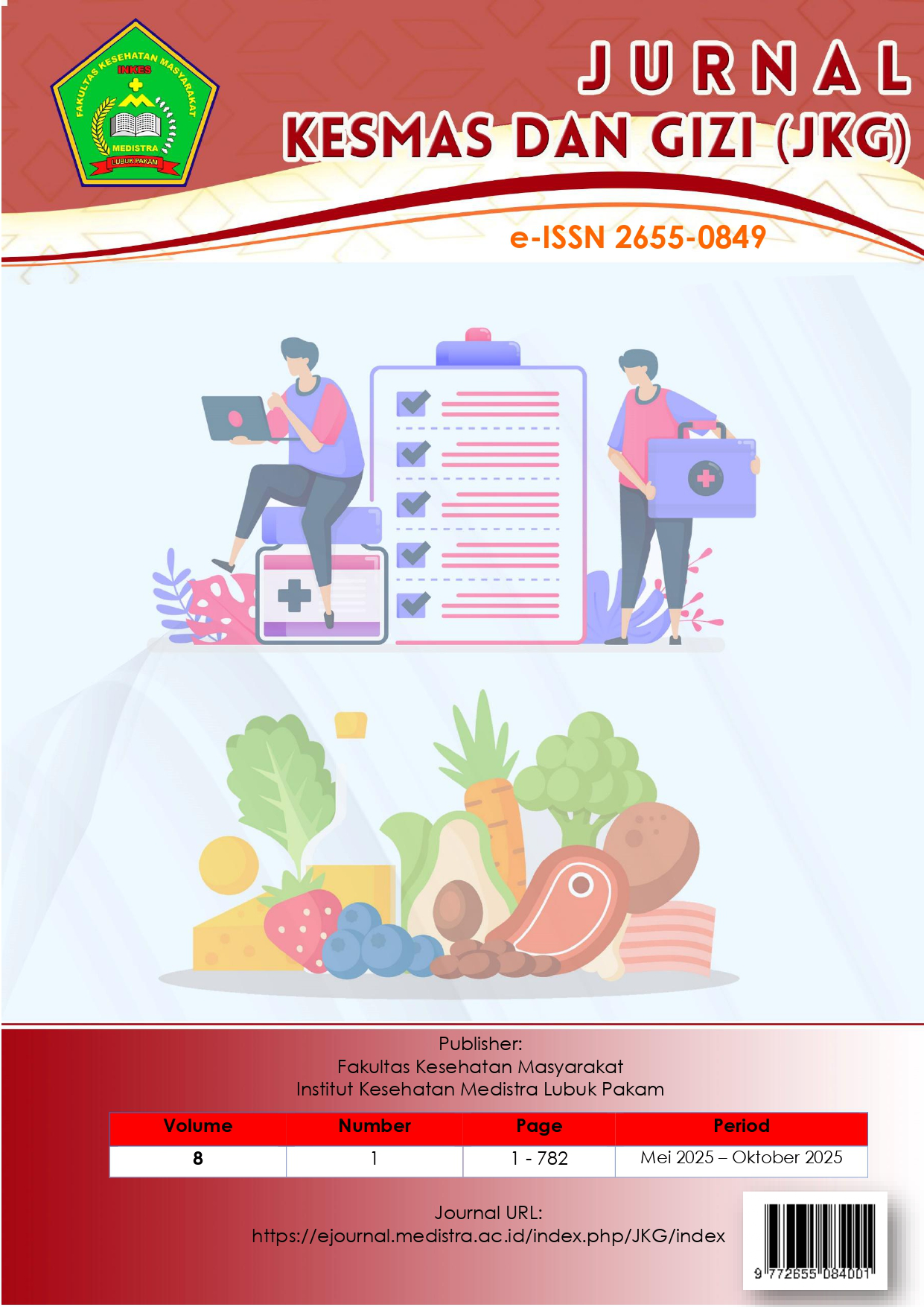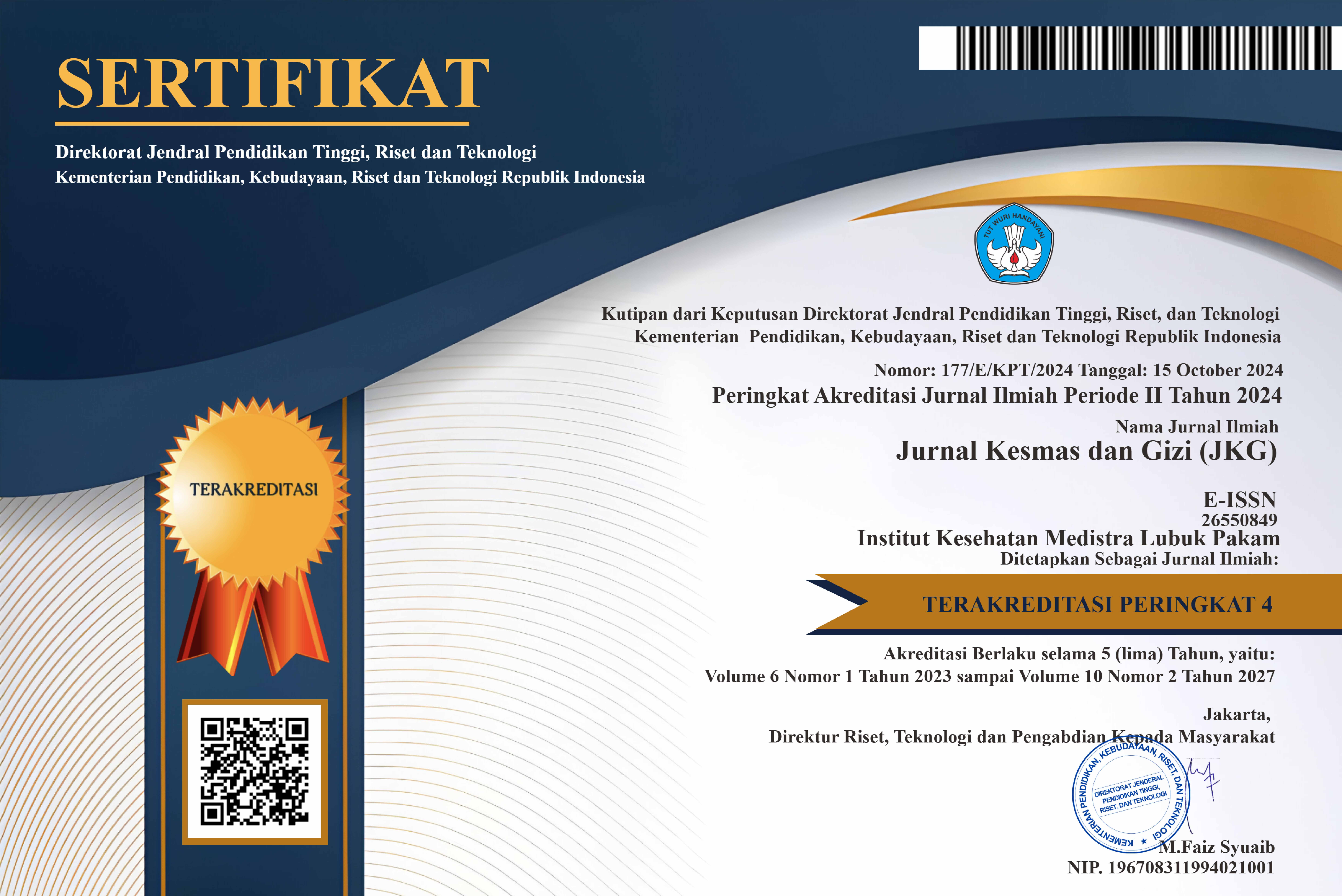Evaluation of the Implementation of Occupational Health and Safety Management System at Lima Puluh Public Health Center, Batu Bara Regency, in 2025
DOI:
https://doi.org/10.35451/c1ftq750Keywords:
SMK3, , puskesmas, penelitian kualitatif., K3Abstract
The Occupational Health and Safety Management System (OHSMS) is a critical component in ensuring a safe and healthy work environment, especially in healthcare service facilities such as community health centers (Puskesmas). This study aims to evaluate the implementation of OHSMS at Lima Puluh Public Health Center in Batu Bara Regency, focusing on three key components: policy establishment, planning, and implementation of OHS plans. A qualitative method with a case study approach was used, and data were collected through in-depth interviews, focus group discussions, observations, and documentation involving 10 informants from the District Health Office and the Puskesmas staff. The results show that although OHS policies have been formally established through official decrees, their implementation remains weak. Most team members were unaware of the decree, had not received OHS training, and lacked written work plans. Risk identification was informal and undocumented, and there was no systematic OHS planning document. The implementation of OHS activities was reactive and relied heavily on staff habits or personal initiatives. Out of 11 OHS standards for healthcare facilities, six had not yet been implemented, including hazard identification and risk control, application of ergonomic principles, periodic health examinations, immunization, management of facilities and infrastructure from an OHS perspective, and emergency or disaster preparedness. The study recommends strengthening management commitment, improving human resource capacity through training, and allocating specific budgets for OHS programs to optimize OHSMS implementation. The Batu Bara District Health and Family Planning Office, as the supervisor of OHSMS implementation, is expected to conduct continuous monitoring and evaluation to ensure sustainable improvement in OHS performance.
Downloads
References
[1] Kemenaker RI, *Permenaker Nomor 5 Tahun 2018 Tentang Keselamatan dan Kesehatan Kerja Lingkungan Kerja*, Jakarta, 2018.
[2] ILO Jakarta, *Keselamatan dan Kesehatan Kerja di Tempat Kerja Sarana Untuk Produktivitas: Pedoman Pelatihan Untuk Manajer Dan Pekerja, Modul Lima*, Jakarta, 2013.
[3] Kemenaker RI, *Profil Keselamatan dan Kesehatan Kerja Nasional Indonesia Tahun 2022*, Cetakan Pertama, Jakarta, 2022.
[4] BPJS Ketenagakerjaan, "Kecelakaan Kerja Makin Marak dalam Lima Tahun Terakhir," [Online]. Available: https://www.bpjsketenagakerjaan.go.id/berita/28681/Kecelakaan-Kerja-Makin-Marak-dalam-Lima-Tahun-Terakhir. [Accessed: Nov. 2, 2024].
[5] Pemerintah Republik Indonesia, *Peraturan Pemerintah Nomor 50 Tahun 2012 tentang Penerapan Sistem Manajemen Keselamatan dan Kesehatan Kerja*, Jakarta: Sekretariat Negara, 2012.
[6] S. Ramadhani, M. Yusuf, and R. Fitriani, "Analisis Ketersediaan Sarana K3 di Puskesmas Wilayah Timur," *Jurnal Kesehatan Masyarakat*, vol. 9, no. 1, pp. 45–52, 2021.
[7] D. M. K. Sidabutar, "Analisa Penerapan SMK3 Mengacu Kepmenkes No. 52 Tahun 2018 di Puskesmas Medan Deli dimasa Pandemi Covid-19," *Jurnal Untuk Masyarakat Sehat (JUKMAS)*, vol. 6, no. 2, Oct. 2022. [Online]. Available: https://ejournal.urindo.ac.id/index.php/jukmas.
[8] Susilawati, "Penerapan Sistem Manajemen Keselamatan dan Kesehatan Kerja (SMK3) di Puskesmas Umbulharjo II Kota Yogyakarta," *Jurnal Kesehatan Vokasional*, vol. 8, no. 2, May 2023. [Online]. Available: https://doi.org/10.22146/jkesvo.72671.
[9] R. K. Yin, *Case Study Research and Applications: Design and Methods*, 6th ed., Thousand Oaks, CA: Sage Publications, 2018.
[10] Sugiyono, *Metode Penelitian Kuantitatif, Kualitatif dan R&D*, 19th ed., Bandung: Alfabeta, 2013.
[11] R. Rachmawati and I. Nurul, "Analisis Kesiapan Implementasi SMK3 di Puskesmas Wilayah Timur Indonesia," *Jurnal Kesehatan Masyarakat*, vol. 12, no. 1, pp. 85–93, 2020.
[12] F. A. Manuele, *Advanced Safety Management: Focusing on Z10 and Serious Injury Prevention*, Wiley, 2008.
[13] R. Wahyuni and D. Putra, "Evaluasi Implementasi Perencanaan SMK3 di Puskesmas Wilayah Timur Indonesia," *Jurnal Kesehatan Lingkungan*, vol. 18, no. 1, pp. 56–64, 2022.
[14] L. Lusianah, R. Sitorus, F. Lestari, T. Muhaimin, and D. Juliastuti, "Implementation of Safety Leadership in Nursing Management: A Systematic Mixed Studies Review," *Open Access Macedonian Journal of Medical Sciences*, vol. 10, no. T8, pp. 5–10, 2022. [Online]. Available: https://doi.org/10.3889/oamjms.2022.9455.
[15] E. P. Pawenrusi, S. Syatriani, and A. I. Fajrina, "Analysis of Occupational Health and Safety Risk Management: Hazard Identification, Risk Assessment, and Risk Control-HIRARC for Workers at Health Quarantine Offices in Makassar, Indonesia," *International Journal of Statistics in Medical Research*, vol. 14, pp. 190–196, 2025. [Online]. Available: https://doi.org/10.6000/1929-6029.2025.14.19.
Downloads
Published
Issue
Section
License
Copyright (c) 2025 Lisdauli Purba, Harris Rambey, Ika Nur Saputri

This work is licensed under a Creative Commons Attribution 4.0 International License.
Copyright in each article is the property of the Author.


























